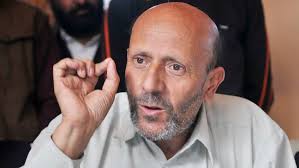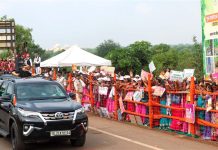In Kashmir, the old order is represented by the NC, the PDP, and the Congress, while the new order is powered by the Apni Party, the DPAP, and the PC led by Sajad Lone with Engineer Rashid’s entry adding another dimension to the already fragmented electoral landscape. A report by Riyaz Wani

In his address in Srinagar on September 19, his first in Kashmir Valley during the ongoing Assembly election, Prime Minister Narendra Modi promised restoration of statehood to Jammu and Kashmir if the BJP was elected to power. And as he made the commitment, stopping short of specifying any timeline, the audience clapped.
He cautioned people against the alliance between Congress and the NC, saying this would have made Pakistan happy. The PM warned that a vote for the Congress would lead to the reinstatement of Article 370, which he said would pave the way for violence to return to the Valley. He made the statement despite the well-known fact that a predominant majority of people in the erstwhile state are upset over the withdrawal of Article 370 that granted Jammu and Kashmir an autonomous status and removed inherited protection on land and jobs.
However, the BJP’s core constituency in Jammu and Kashmir is not the Kashmir Valley but the Jammu division. In 2014, the party had by and large swept the division, securing 25 out of the then 37 seats. But the electoral scene for the party now is not as conducive as it was in 2014 when the Modi wave was at its peak. The ground looks a bit shaky now.
However, the saffron party hopes to better its tally than the 25 seats it garnered in 2014, enabling it to form a government with support from major or smaller Kashmir-origin parties or independents.
In Kashmir Valley, on the other hand, the BJP faces a difficult task of peddling a political narrative that is contrary to aspirations of a large majority of people of the union territory. People here want restoration of Article 370 and the attendant rights. They also want an empowered Assembly unlike what is on offer, and more importantly the restoration of statehood. But none of these is being offered by the BJP. As for the statehood, the promise is undone by the lack of a timeline. But for the BJP, Kashmir is not where it hopes to do well.
No visible wave
The Assembly election in Jammu and Kashmir has not generated a wave in favour of any political party, including that for Engineer Rashid who was supposed to galvanize a mass mobilization soon after his release. But this hardly means he hasn’t whipped up the passion. He has both livened up the electoral scene and also made the outcome further unpredictable.
He is drawing good crowds all across the Valley, although still short of expectations. In South Kashmir, which is not his constituency, the crowds rooted for him wherever he went. It is still not certain whether he will win seats across the Valley, but he is certain to create a major disruption. His presence has already strained the grip of the established parties like the NC, PDP and the Congress, as well as the smaller parties like the People’s Conference.
The recent alliance between Rashid and Jamaat independents have introduced a new factor into the evolving political tug of war.
At the same time, like the BJP in Jammu division, the National Conference is the favourite party in the Valley to win the majority of seats. But this initial perception has been dented by the intensifying electoral competition as the campaign progresses. The NC now barely holds on to its initial edge in the campaign. For example, in South and Central Kashmir, the PDP, Jamaat-i-Islami and even Rashid’s Awami Ittehad Party (AIP) have crowded the electoral scene, making the outcome uncertain
The PDP, Jamaat and the AIP have drawn massive crowds. North Kashmir, on the other hand, has taken an interesting turn: While earlier, the media attention was mainly focussed on the battle royale between the NC and Sajjad Lone’s People’s Conference, a wild card entry of Rashid has dramatically shifted the dynamics of the electoral race. Since his release on September 11, Rashid has been running a high-energy campaign and attracting large crowds even in areas that have not traditionally been supportive of his party. Although the groundswell is still short of what could be called a wave in his favour, all bets seem to be off now.
The new political outfits like the Democratic Progressive Azad Party (DPAP) floated by the former top Congress leader Ghulam Nabi Azad and the Apni Party led by the businessman turned-politician Altaf Bukhari are also in the fray, but they haven’t made much of a mark so far, more so the former. As for Azad, this is such a fall from the position of being once one of the foremost national leaders to a regional leader running a district level party.
Old versus new order
Essentially, the ongoing election in Kashmir is a contest between the traditional mainstream political narrative and the new-fangled politics of the past five years.
The old order is represented by the National Conference and the PDP as well as the Congress party, which is a national party though. The BJP’s rise in the former state is a post 2014 phenomenon, when for the first time it won 25 of 37 seats from Jammu division in the then Assembly elections. The party subsequently formed a coalition government with the PDP which secured 28 seats.
The new order is represented by the Apni Party led by the businessman-turned politician Altaf Bukhari, the DPAP headed by Azad and the People’s Conference of Sajad Lone. Although the PC is an old party, its new avatar owes itself to the political restructuring of the Valley following the abrogation of Article 370 in August 2019.
After the recent parliament elections, the ongoing Assembly election is the first major electoral exercise in which the old and the new political orders have come face to face. And at the heart of this contest are now almost all constituencies. Rashid’s entry seems to have already changed the game in Kupwara.
Although Kashmir has witnessed many elections over the decades, this one is likely to go down as one the most interesting and also “heavily engineered,” as claimed by the PC leader Sajad Lone in one of his interviews. Not only are several political parties vying for votes but there are also many independents in the fray. This has confused the voter, preventing the formation of a coherent public opinion.
“The anticipated division and sub-division of votes will profoundly impact the Valley’s representation in the Assembly. Whether to its advantage or detriment, only time will tell,” an editorial in a local daily said. “This is why it is incumbent on people to exercise their franchise very sensibly this time.












